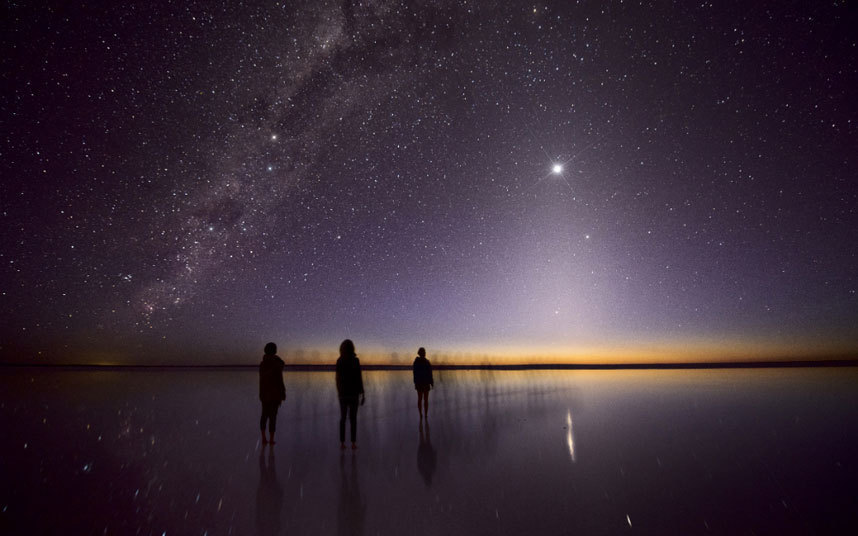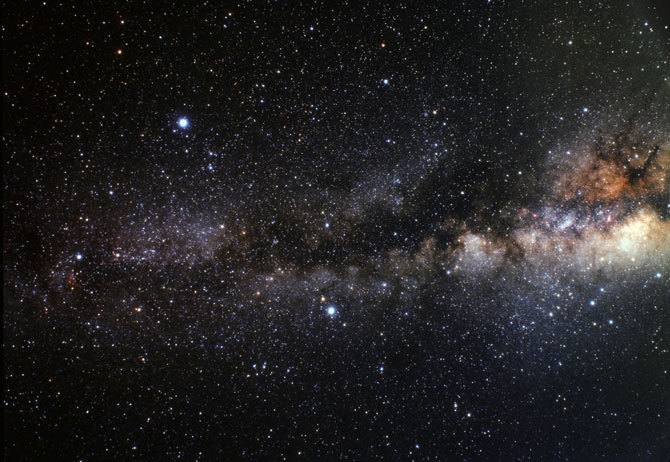Are we alone in the universe?

We are still continuing to look for any signals of extraterrestrial civilizations. This intense and anxious listening to the air has already generated a lot of speculation. Naturally, the most obvious explanation of the Great Silence is that, besides us, there is simply no one to "get in touch." It is very unpleasant to admit it, but still there are enough grounds for such a conclusion.
Long before the time when the great physicist Enrico Fermi raised the question “Where is everyone?”, People wondered why there are no signals from extraterrestrial civilizations. As Fermi correctly noted, mathematics cannot explain this. Our galaxy is about 13 billion years old, and this is more than enough for hypothetical other civilizations to have time to explore and colonize. According to one of the works , this process can take from tens of millions to one billion years. In other words, in theory, we should have met someone.

')
However, the complete absence of confirmed contacts led astronomer Michael Hart to assume that a civilization capable of interstellar travel simply does not exist. However, this “absence” may be the result of any considerations on their part, including the reluctance to explore space, or excessive technological complexity. Despite the recent discoveries of a number of potentially habitable exoplanets, as well as our feeling that the Universe is simply meant for life, a number of considerations make us think that we are still unique in all senses of the word.
In the right place at the right time
Astronomer Paul Davis once said : “In order for the planet to be populated, two conditions must be met: the planet must be suitable for this, and one day life must arise on it” (thanks, Cap). The existence of life, from the point of view of modern science, depends on the presence of five critical chemical elements: sulfur, phosphorus, oxygen, nitrogen and carbon. These elements are synthesized during thermonuclear reactions in the depths of stars, and at the end of their life cycle they spread through space. Therefore, over time, the concentration of these substances gradually increases.

But what a moment: the concentration of these substances in interstellar space only relatively recently reached a level at which the appearance of life is possible. That is, the planets around older stars must be poor with these five elements. Our sun belongs to quite young stars. So we can be among the first civilizations that appeared, or even the very first.
From this point of view, disagree Steven Webb. He believes the role of the concentration of chemical elements in our appearance is exaggerated. For example, we do not know what their concentration should be in a star so that life would arise on one of the surrounding planets. Moreover, the proportion of each element varies greatly depending on the class of the star. In other words, we simply have no reason to blame the lack of concentration of chemical elements.
Gamma-ray flashes: an evolutionary reset button
Another reason for the lack of signals from other civilizations may be the fact that our galaxy is the source of frequent gamma-ray bursts (WGI). By frequent is meant about one every several billion years. WGI is one of the most energetically powerful phenomena known to us today. It is believed that they occur in supernova explosions collapsing into black holes, or in collisions of neutron stars. According to statistics, in the entire observable Universe every day occurs through a flare of gamma radiation.

A fairly close emission of radiation from a supernova explosion can destroy the biosphere of a planet of the terrestrial type, instantly killing all life on the surface and at a certain depth (underwater and lithoautotrophic ecosystems must survive). Gamma radiation also provokes chemical reactions, during which up to 90% of the ozone layer will be destroyed, as a result the planet will be burned out by the hard ultraviolet radiation of its star.
In 1999, a paper was published in which it was suggested that WGI could be the cause of mass extinction on any habitable planet at a distance of up to 10,000 light years. For comparison, the diameter of the Milky Way disk is about 100,000 light-years, and its thickness is about 1,000. Thus, a single flash can "sterilize" an essential part of our galaxy.
According to one study , the likelihood of such exposure depends on the location of the planet and time. The closer the planet to the galactic core, where the density of stars is highest, the greater the likelihood. According to the model, the probability of hitting a lethal WGI every billion years, in the vicinity of the core is 95%. At a distance of half the distance from the core to the solar system, the probability decreases to 80%.
But there is a nuance. The frequency of WGI in the past was higher, which was due to the lower concentration of heavy elements in the Milky Way. In other galaxies rich in elements heavier than hydrogen and helium, less WGI is noted. And with the saturation of our galaxy with heavy elements, the frequency of WGI decreased. And this may indicate that 5 billion years ago and earlier the probability of the death of extraterrestrial life from the WGI was more than high. Some scientists believe that the Earth has not avoided this fate many billions of years ago. Given the high estimated frequency of occurrence of the WGI in the past, they can be called peculiar reset buttons that “reset” habitable planets at best into the state of the microbial biosphere.
So it can be assumed that, with a decrease in the frequency of the WGI, our galaxy is now in an equilibrium phase in the transition from a lifeless void to the ubiquitous appearance of extraterrestrial civilizations. So we may not be alone, but many more civilizations are actively developing along with us.
The theory is fascinating, but still inconclusive for some scientists. For example, the astronomer Milan Chirkovich believes that in this case the frequency of the WGI should have changed very dramatically in order to speak of a noticeable boundary between the phases of the development of life in the Milky Way. He does not deny the very fact of reducing the number of WGI, but this is clearly not enough to explain the Great Silence. Probably, their role is exaggerated, moreover, it is completely unknown how much time must pass from the "sterilization" to the revival of life up to a sufficiently advanced civilization.
Our unique Earth
Another possible reason for our loneliness is the Hypothesis of the Unique Earth . According to her, the conditions for the emergence of a civilization capable of space travel are extremely harsh. This idea originated in 1999 with the paleontologist Peter Ward and the astronomer Donald Brownlee as a result of a comparison of the latest research in astronomy, biology and paleontology. Scientists have compiled a list of parameters that, in their opinion, make our planet incredibly rare. So rare that we are unlikely to meet another civilization.

Mentioned list looks like this:
- The correct location in the galaxy is the right type . In galaxies, there are desert zones resulting from gamma and x-ray outbreaks, changes in the concentration of heavy elements and the gravitational influence of stars on planets and planetesimals , which can lead to collisions of celestial bodies.
- Rotation at the correct distance around the star of the correct type . Our planet is located in the so-called zone of Goldilocks of our star system, in which the most favorable conditions for the emergence of complex life forms.
- Star system with the correct set of planets . Without the gas giants of Jupiter and Saturn, life on Earth could not have arisen. By the way, the planet type "hot Jupiter" are very common.
- Stable orbit . In binary stellar systems, the orbits of the planets are unstable, as a result, they periodically leave the habitable zones. And binary systems are very common in the Milky Way, almost half of the total.
- Earth-like planet of the correct size . Adequate land area, a stable atmosphere and a moderate level of gravity are needed for evolutionary processes to take place.
- Plate tectonics . This process regulates the temperature change of the Earth’s climate. If we did not have tectonics, and the average annual temperature would be very unstable.
- Large balancing satellite . Our Moon helps the Earth to maintain a certain angle of inclination of the axis, which is the reason for the change of seasons of the year.
- The trigger mechanism of the evolutionary process of the birth of a complex life form . The transition from simple unicellular organisms (prokaryotes) to multicellular (eukaryotes) can be one of the most difficult stages of evolution.
- The right time in cosmic evolution . The early periods of the existence of our galaxy and planet were not the best time for the birth of life, given the frequent fall of celestial bodies, going wild, volcanism, unstable atmosphere and gamma-ray flashes.
Admittedly, the list is rather discouraging. But many scientists consider him far-fetched. For example, according to calculations, in our galaxy there should be about 40 billion potentially inhabited planets , life can arise in a rather extreme environment. And some parameters, such as the role of Jupiter and plate tectonics, are clearly overvalued.
Our unique civilization
It is possible that life is, in fact, very widespread in the universe. Just the very fact of the emergence of our civilization. What makes us think that the use of tools, technological progress and the creation of a complex language are standard steps?

As far as we now know, a complex form of life originated on Earth about two billion years ago, and terrestrial invertebrates - 500 million years ago. Throughout this huge period of time, no species of living beings on the planet has reached any of the mentioned developmental stages. Perhaps the same thing is happening across the galaxy, and for some reason we have become an exception.
Only for us
There is another hypothesis explaining our loneliness in the Universe, although it already relates to philosophy. It is called the Strong Anthropic Principle . In short, its essence lies in the fact that the Universe is not intended for the existence of life, but only for intelligent life, man. A very controversial theory that smacks of creationism and rejects some obvious evidence to the contrary.

Of course, we are not talking about the fact that the Universe was created by some supernatural forces. Or that we are the product of a computer simulation of a highly developed civilization. This hypothesis implies only that we see the Universe exactly such, because here there are conditions that allow us and to be observers.
Conclusion
There are many other theories explaining the Great Silence. Perhaps the theory of parallel development of a large number of civilizations is closer to me than our complete loneliness. And if we really are in a group of leaders, that would be great. This would mean that we have a lot of chances to create our own future.
Source: https://habr.com/ru/post/362919/
All Articles